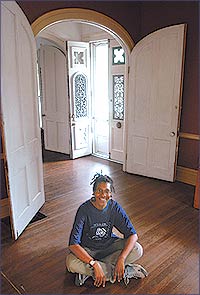


 |
 |
Issue Contents : : Feature Stories : : History's House : : Page [ 1 2 ]
"There are a lot of people who don't know who Langston is
and what he accomplished," Smith said. "This house is amazing,
and I plan to take some of it back with me to share with my students."
 |
|
| Olivia
Cousins Photo by Darryl Polk |
|
"Many homes on the Underground Railroad are owned by white people
who tell stories about the routes from their own eyes," said Cousins. "When
you tell a story that's not yours, it comes out differently. I always
wanted to own a home on the Underground Railroad--to keep alive the
stories people rarely talk about. The Langston House, with its rich history,
is an ideal setting from which to tell these stories."
Jason Clark '02 was the treasurer of OSCA/OSCA Properties when the home
was put up for sale. He said the house had an estimated 125 years of white
ownership, which is ironic, considering that Langston himself spent a lifetime
in the defense and uplifting of black people.
"Langston was a very proud person, and this physical representation of his autonomy was owned by white people," said Clark, himself a descendant of the famous American explorer William Clark. "My family background has made me aware of how history lives in the present. It gives all of us endowed responsibilities."
In searching for potential owners, Clark, along with OSCA president Forrest Crawford '02 and members Kasi Chakravartula '02 and Amber McMillan '03, made every effort to identify a person or organization who would appreciate the significance of Langston House and commit to its renovation.
"Dr. Cousins was pretty excited, and she had definite plans for the property," said Clark, referring to Cousins' vision of creating an African American artist-in-residence program in conjunction with the College and converting the house into a combination living museum and educational resource/community center. Cousins also hopes to initiate a Langston speaker series and offer tours and workshops to local schoolchildren.
"The home's continuing significance to the African American
community in Oberlin persuaded OSCA to vote for its sale to Dr. Cousins," said
Clark. The property changed hands officially in July 2002.
Although enthusiastic about her plans, challenges still loom for Cousins. She
relies on community volunteers for minor repairs to the house, but admits to
needing more help and money before tackling larger renovation and resurfacing
projects. Soon, she said, she hopes to resign as chair of the health education
department at the Borough of Manhattan Community College in New York and relocate
to Oberlin.
"I consider myself a steward of this property, my hope being to share Langston's life and home with others."